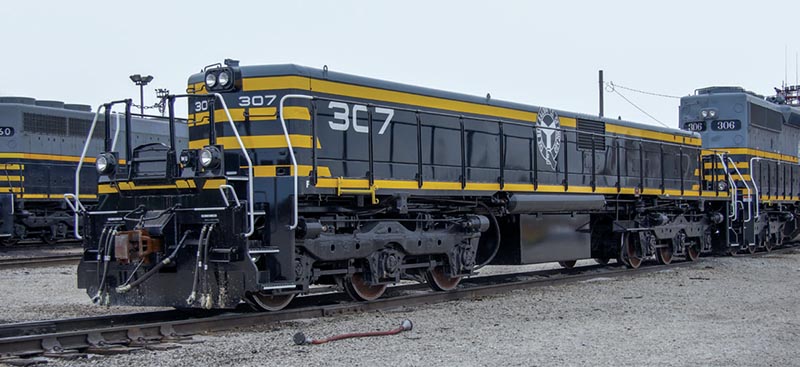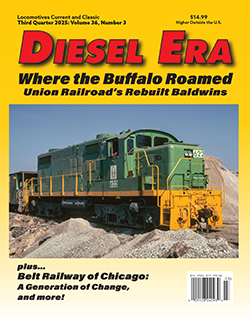 by Sean Graham-White/photos by the author
by Sean Graham-White/photos by the author
As you stand in Clearing Yard in 1995, a swivel of your head would show pneumatic tubes to transport paperwork around the yard, video cameras to proof incoming freight cars, and Alco locomotives. Would you believe this was a terminal railroad that was essential to operations in Chicago? The Belt Railway Company of Chicago (BRC) was long associated with a locomotive roster that included classic Geeps, switchers, and Alcos, some dating back to 1949.
As the years went by, technology and railroad operations evolved even if the unique, all four-axle BRC roster did not. By the mid-1990s it was obvious changes were necessary, including the possibility of six-axle locomotives. An outside consultant studied the fleet and determined 32 more modern locomotives could handle the work that the 48 older ones had been accomplishing. Thirty years later (in 2025), BRC is performing that work with even fewer locomotives than that mentioned study anticipated. BRC is a “belt” railroad connecting with all major railroads in Chicago, serving various industries, while operating the immense Clearing Yard which features a double hump — allowing classification of freight cars in two directions at the same time. As the largest intermediate switching terminal railroad in the country that means there is a need for transfer, pull down, humping, and switching power across its 28 main line miles and 300 miles of switching tracks. Clearing Yard itself is more than 250 miles of track. Currently, the railroad handles up to 8,000 freight cars per day, with about 3,000 of those passing over the hump. Each day there are 25 freight trains in and 25 out of Clearing, one to two transfers, and about 15 other trains running through the BRC. Compared to 1995, just prior to the decision to change the fleet, that’s 3,000–5,000 more freight cars per day, around the same number of freight trains and 8–13 fewer transfers.
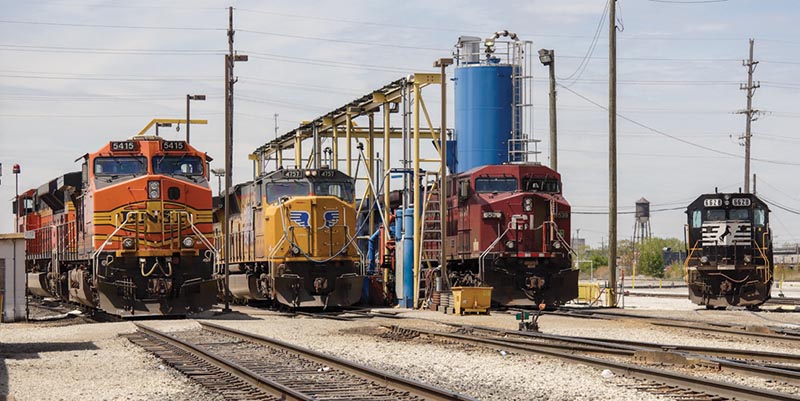
ABOVE: Other railroads deliver trains to BRC using their own power, which often lays over and is sometimes serviced before it takes a train heading back. This means BRC’s diesel shop can have a wide variety of power in it at any given time. In 2023, the Belt averaged servicing 356 foreign units each month and their own units 121 times. This view is from April 23, 2014.
As the existing fleet grew older it became increasingly difficult to maintain, while at the same time the trains BRC was handling were becoming longer and heavier. For example, the advent of heavier freight cars had a huge impact on operations — one hundred 200,000-lb. cars weigh significantly less than the same train with 286,000-lb. examples… plus train lengths were growing up to 180 cars. A hump set typically uses two locomotives to push a cut of cars over it — and despite BRC having had the heaviest GP38-2s built, they began to strain at their job and sometimes stalled. And MP15s used in hump service fared even worse, despite also having a weight of 280,000 lbs. Both had 65:12 gearing, but they were at the end of their usefulness in that service. Ron Batory joined the Belt as its president in 1993, and after long discussions with then-Chief Mechanical Officer Ken Smith, “got the ball rolling with Kenny,” to start planning on change. Ken had followed in his father, Vernon’s, footsteps with a practice of basing needs on horsepower rating. But technology was progressing in ways to help the Belt advance toward the next generation of locomotives. Instead of basing on horsepower, a shift was made to tractive and braking effort. One big problem, according to Batory: “we know what we want but nobody’s building it,” since EMD and GE had stopped offering switching and four-axle locomotives.
Fleet transition began in the late 1990s soon after Batory left in 1998. This was going to be immense transformational change and he noted there was a fear of change or potential failure. But as Batory departed, a new chief mechanical officer took charge in 1999 — Mike O’Donnell. Mike had decades of experience at the Belt, having started as a carman in 1974 and progressing as car foreman, lead foreman, and trainmaster. The Alcos and GP38-2s were traded to LLPX in exchange for 13 EMD SD40s, since six-axle locomotives have better tractive ability at low speed. At this same time, BRC’s GP7s, cow-calf switcher sets, SW9s, SW1200s, and half of the MP15DCs were replaced by GP10s and SW1500s. In the case of the MP15DCs, it just so happened their lease ran out in this timeframe.
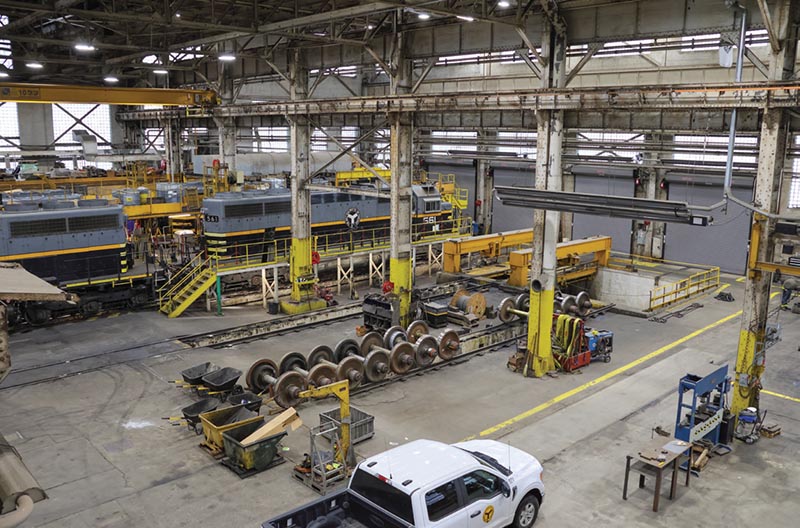
ABOVE: The 51,000 sq. ft., five-story diesel shop at the Belt also received some up-grades at the same time the locomotive fleet was modernized. Decades’ worth of junk was thrown out and old, irrelevant tooling was removed. In addition to new tooling and parts, two remote control overhead cranes were also added. This view was taken December 20, 2024.
Between 1997–2003, 43 locomotives left the roster, with 22 locomotives replacing them. One thing that helped during this transition, and thanks to computerization and better communications/data, was that Class 1s began to deliver trains with over-the-road crews, and the Belt began to produce Class 1 train plans into their blocking to build outbound road trains ready to depart Chicago, thus reducing the need to operate daily (or almost daily) transfers with Belt power to other yards. It should be noted that Chicago’s yards were a significant source of delay in the terminal, so any way to avoid adding stops provided massive benefits. Class 1s blocked trains at yards away from Chicago if at all possible. A couple of examples would be BNSF’s Galesburg Yard and Norfolk Southern’s (NS) Elkhart Yard.
BRC made the decision to create five Mother-Hump Slug sets. This shift to Mother-Hump Slug sets encountered an impediment — old-school thinking by the operators based on what they had done for decades before! “When we introduced them,” says O’Donnell, “operators complained, ‘we need more horsepower.’ So we created a training video. We filmed the inside of the slug and showed the ballast to assure the rank and file that we needed weight on the drivers more than horsepower. I remember we shared an analogy in the short training film: When stuck in the snow, do you need a 4-wheel drive Jeep or a race car?”
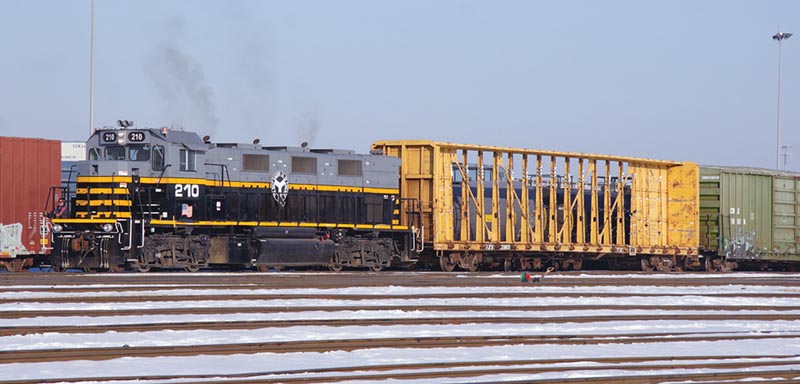
ABOVE: BRC 3GS21B 210 shoves hard on a cut of cars on January 15, 2012. The unit is one of two 3GS21Bs, along with a similar 2GS14B on Belt Railway of Chicago’s roster that came from National Railway Equipment.
In the midst of all this change, the BRC was testing various motive power to see what technology would best suit its needs moving forward … BLC MP1500D, MP2000D, and MP2000C, SD40Es from NS, a Neptune 3GS21B-Slug set provided by National Railway Equipment (NRE), Railpower Gensets, and more. Results of testing were carefully calculated and the ZTR control system the NS units used would be installed after 2009 in the initial and later hump sets and MP15s, providing much better tractive effort. Three Gensets would be ordered. Add in a shift to remote control operation (RCL) of locomotives by the mid-2000s, and the small railroad would see huge changes in a short period of time.
O’Donnell noted that the implementation of RCL was the biggest technology shift he saw as CMO. He explains, “BRC put together a team from Signal, Operations, Engineering, and Mechanical. We all had different goals to complete as we implemented RCL in each yard in successive order: west yard, east yard, hump, and finally industry jobs…we used two different contract shops for installation: Relco and NRE. We needed to keep up with the training. Signal had to keep pace with repeaters, testing, and pull back protection on yard leads. I believe implementation took 18 months.” Pull Back Protection is a set of sensors in the track that interact with GPS to tell RCL when the locomotive is nearing the end of the track that allows a two-man crew to stay up at the work end protecting the shove for them…


